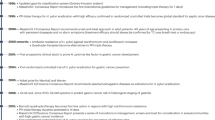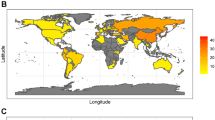Abstract
Helicobacter pylori leads to chronic gastritis, peptic ulcer disease and gastric cancer. With increasing issues of antibiotic resistance and changing epidemiology of this pathogen, new approaches are needed for effective management. In 1984, Dr Barry Marshall and Dr Robin Warren reported the association of Helicobacter pylori with peptic ulcers in The Lancet—a discovery that earned them the Nobel prize in Physiology or Medicine in 2005—but what progress have we made since then? Here, we have invited three international experts to give their insights into the advances in H. pylori research over the past 30 years and where research should be focused in the future.
This is a preview of subscription content, access via your institution
Access options
Subscribe to this journal
Receive 12 print issues and online access
$189.00 per year
only $15.75 per issue
Buy this article
- Purchase on SpringerLink
- Instant access to full article PDF
Prices may be subject to local taxes which are calculated during checkout
Similar content being viewed by others
References
[No authors listed] Schistosomes, liver flukes and Helicobacter pylori. IARC Working Group on the evaluation of carcinogenic risks to humans. Lyon, 7–14 June 1994. IARC Monogr. Eval. Carcinog. Risks Hum. 61, 1–241 (1994).
Parkin, D. M. The global health burden of infection-associated cancers in the year 2002. Int. J. Cancer 118, 3030–3044 (2006).
Helicobacter and Cancer Collaborative Group. Gastric cancer and Helicobacter pylori: a combined analysis of 12 case control studies nested within prospective cohorts. Gut 49, 347–353 (2001).
Fock, K. M. et al. Asia–Pacific consensus guidelines on gastric cancer prevention. J. Gastroenterol. Hepatol. 23, 351–365 (2008).
Lee, Y. C. et al. The benefit of mass eradication of Helicobacter pylori infection: a community-based study of gastric cancer prevention. Gut 62, 676–682 (2013).
Graham, D. Y. & Asaka, M. Eradication of gastric cancer and more efficient gastric cancer surveillance in Japan: two peas in a pod. J. Gastroenterol. 45, 1–8 (2010).
Comfort, M. W. Gastric acidity before and after development of gastric cancer: its etiologic, diagnostic and prognostic significance. Ann. Intern. Med. 36, 1331–1348 (1951).
Cotton, P. NIH consensus panel urges antimicrobials for ulcer patients, skeptics concur with caveats. JAMA 271, 808–809 (1994).
Graham, D. Y., Lu, H. & Yamaoka, Y. Y. Therapy for Helicobacter pylori infection can be improved: sequential therapy and beyond. Drugs 68, 725–736 (2008).
Warren, J. R. & Marshall, B. Unidentified curved bacilli on gastric epithelium in active chronic gastritis. Lancet 321, 1273–1275 (1983).
Marshall, B. J. & Warren, J. R. Unidentified curved bacilli in the stomach of patients with gastritis and peptic ulceration. Lancet 1, 1311–1315 (1984).
Malfertheiner, P., Chan, F. K. & McColl, K. E. Peptic ulcer disease. Lancet 374, 1449–1461 (2009).
Amieva, M. R. & El-Omar, E. M. Host–bacterial interactions in Helicobacter pylori infection. Gastroenterology 134, 306–323 (2008).
Wotherspoon, A. C., Ortiz-Hidalgo, C., Falzon, M. R. & Isaacson, P. G. Helicobacter pylori-associated gastritis and primary B-cell gastric lymphoma. Lancet 338, 1175–1176 (1991).
Ruskoné-Fourmestraux, A. et al. Gastric extranodal marginal zone B-cell lymphoma of MALT. Gut 60, 747–758 (2011).
Nakamura, S. et al. Long-term clinical outcome of gastric MALT lymphoma after eradication of Helicobacter pylori: a multicentre cohort follow-up study of 420 patients in Japan. Gut 61, 507–513 (2012).
Hatakeyama, M. Helicobacter pylori and gastric carcinogenesis. J. Gastroenterol. 44, 239–248 (2009).
Correia, M., Machado, J. C. & Ristimäki, A. Basic aspects of gastric cancer. Helicobacter 14 (Suppl. 1), 36–40 (2009).
Mizuno, S. et al. Prescreening of a high-risk group for gastric cancer by serologically determined Helicobacter pylori infection and atrophic gastritis. Dig. Dis. Sci. 55, 3132–3137 (2010).
Vakil, N. & Megraud, F. Eradication therapy for Helicobacter pylori. Gastroenterology 133, 985–1001 (2007).
Tepes, B., O'Connor, A., Gisbert, J. P. & O'Morain, C. Treatment of Helicobacter pylori infection. Helicobacter 17 (Suppl. 1), 36–42 (2012).
Malfertheiner, P. et al. Management of Helicobacter pylori infection—the Maastricht IV/Florence Consensus Report. Gut 61, 646–664 (2012).
Blaser, M. J. Equilibria of humans and our indigenous microbiota affecting asthma. Proc. Am. Thorac. Soc. 9, 69–71 (2012).
Kobayashi, I. et al. Changing antimicrobial susceptibility epidemiology of Helicobacter pylori strains in Japan between 2002 and 2005. J. Clin. Microbiol. 45, 4006–4010 (2007).
Ang, T. L. et al. Is there still a role for empiric first-line triple therapy using proton pump inhibitor, amoxicillin and clarithromycin for Helicobacter pylori infection in Singapore? Results of a time trend analysis. J. Dig. Dis. 14, 100–104 (2013).
Liou, J. M. et al. Sequential versus triple therapy for the first-line treatment of Helicobacter pylori: a multicentre, open-label, randomised trial. Lancet 381, 205–213 (2013).
Graham, D. Y. & Rimbara, E. Understanding and appreciating sequential therapy for Helicobacter pylori eradication. J. Clin. Gastroenterol. 45, 309–313 (2011).
Rimbara, E., Fischbach, L. A. & Graham, D. Y. Optimal therapy for Helicobacter pylori infections. Nat. Rev. Gastroenterol. Hepatol. 8, 79 (2011).
Vécsei, A. et al. Stool polymerase chain reaction for Helicobacter pylori detection and clarithromycin susceptibility testing in children. Clin. Gastroenterol. Hepatol. 8, 309–312 (2010).
Zhang, S., Moise, L. & Moss, S. F. H. pylori vaccines: why we still don't have any. Hum. Vaccin. 7, 1153–1157 (2011).
Moss, S. F. et al. HelicoVax: epitope-based therapeutic Helicobacter pylori vaccination in a mouse model. Vaccine 29, 2085–2091 (2011).
Kabir, S. The current status of Helicobacter pylori vaccines: a review. Helicobacter 12, 89–102 (2007).
Del Giudice, G., Malfertheiner, P. & Rappuoli, R. Development of vaccines against Helicobacter pylori. Expert Rev. Vaccines 8, 1037–1049 (2009).
Aebischer, T. et al. Correlation of T cell response and bacterial clearance in human volunteers challenged with Helicobacter pylori revealed by randomised controlled vaccination with Ty21a-based Salmonella vaccines. Gut 57, 1065–1072 (2008).
Malfertheiner, P. et al. Safety and immunogenicity of an intramuscular Helicobacter pylori vaccine in noninfected volunteers: a phase I study. Gastroenterology 135, 787–795 (2008).
Bühling, A., Radun, D., Muller, W. A. & Malfertheiner, P. Influence of anti-Helicobacter triple therapy with metronidazole, omeprazole and clarithromycin on intestinal microflora. Aliment. Pharmacol. Ther. 15, 1445–1452 (2001).
Lee, Y. Y., Mahendra Raj, S. & Graham, D. Y. Helicobacter pylori infection—a boon or a bane: lessons from studies in a low-prevalence population. Helicobacter http:///dx.doi.org/10.1111/hel.12058.
Liu, Y., Akiyama, J. & Graham, D. Y. Current understandings of Helicobacter pylori, peptic ulcer and gastroesophageal reflux disease. Minerva Gastroenterol. Dietol. 52, 235–248 (2006).
Bik, E. M. et al. Molecular analysis of the bacterial microbiota in the human stomach. Proc. Natl Acad. Sci. USA 103, 732–737 (2006).
Osaki, T. et al. Comparative analysis of gastric bacterial microbiota in Mongolian gerbils after long-term infection with H. pylori. Microb. Pathog. 53, 12–18 (2012).
Graessler, J. et al. Metagenomic sequencing of the human gut microbiome before and after bariatric surgery in obese patients with type 2 diabetes: correlation with inflammatory and metabolic parameters. J. Pharmacogenomics http://dx.doi.org/10.1038/tpj.2012.43.
Jakobsson, H. et al. Macrolide resistance in the normal microbiota after Helicobacter pylori treatment. Scand. J. Infect. Dis. 39, 757–763 (2007).
Thirumurthi, S. & Graham, D. Y. Helicobacter pylori infection in India from a western perspective. Indian J. Med. Res. 136, 549–562 (2012).
Fock, K. M. et al. Second Asia–Pacific Consensus Guidelines for Helicobacter pylori infection. J. Gastroenterol. Hepatol. 24, 1587–1600 (2009).
Strugatsky, D. et al. Structure of the proton-gated urea channel from the gastric pathogen Helicobacter pylori. Nature 493, 255–258 (2013).
Acknowledgements
K. M. Fock has received grants from Health Sector Development Programme and National Medical Research Council. The author would also like to acknowledge assistance from Dr T. L. Ang in the preparation of this manuscript. D. Y. Graham is supported in part by the Office of Research and Development Medical Research Service Department of Veterans Affairs, Public Health Service grant DK56338 (which funds the Texas Medical Center Digestive Diseases Center), DK067366 and CA116845. The contents are solely the responsibility of the authors and do not necessarily represent the official views of the Veterans Affairs or NIH.
Author information
Authors and Affiliations
Ethics declarations
Competing interests
K. M. Fock declares no competing interests. D. Y. Graham is an unpaid consultant for Novartis in relation to vaccine development for treatment or prevention of H. pylori infection. D. Y. Graham is also a paid consultant for RedHill Biopharma regarding novel H. pylori therapies and for Otsuka Pharmaceuticals regarding diagnostic testing. He has received royalties from Baylor College of Medicine for patents covering materials related to 13C-urea breath test. P. Malfertheiner is paid to give lectures at symposia related to H. pylori infection and acid-related disorders from AstraZeneca, Falk Foundation and Takeda.
Rights and permissions
About this article
Cite this article
Fock, K., Graham, D. & Malfertheiner, P. Helicobacter pylori research: historical insights and future directions. Nat Rev Gastroenterol Hepatol 10, 495–500 (2013). https://doi.org/10.1038/nrgastro.2013.96
Published:
Issue date:
DOI: https://doi.org/10.1038/nrgastro.2013.96
This article is cited by
-
The clinical significance of some serum tumor markers among chronic patients with Helicobacter pylori infections in Ibb Governorate, Yemen
Infectious Agents and Cancer (2023)
-
Investigation of Aryl Hydrocarbon Receptor, Zinc, and Vitamin B12 Levels in Chronic Gastritis with Helicobacter pylori Infection
Biological Trace Element Research (2021)
-
Effect of Saccharomyces boulardii CNCM I-745 as complementary treatment of Helicobacter pylori infection on gut microbiome
European Journal of Clinical Microbiology & Infectious Diseases (2020)
-
Diagnose und Therapie des Adenokarzinoms des Magens und des ösophagogastralen Übergangs
Forum (2020)
-
Comparison of concomitant therapy versus standard triple-drug therapy for eradication of Helicobacter pylori infection: A prospective open-label randomized controlled trial
Indian Journal of Gastroenterology (2019)



